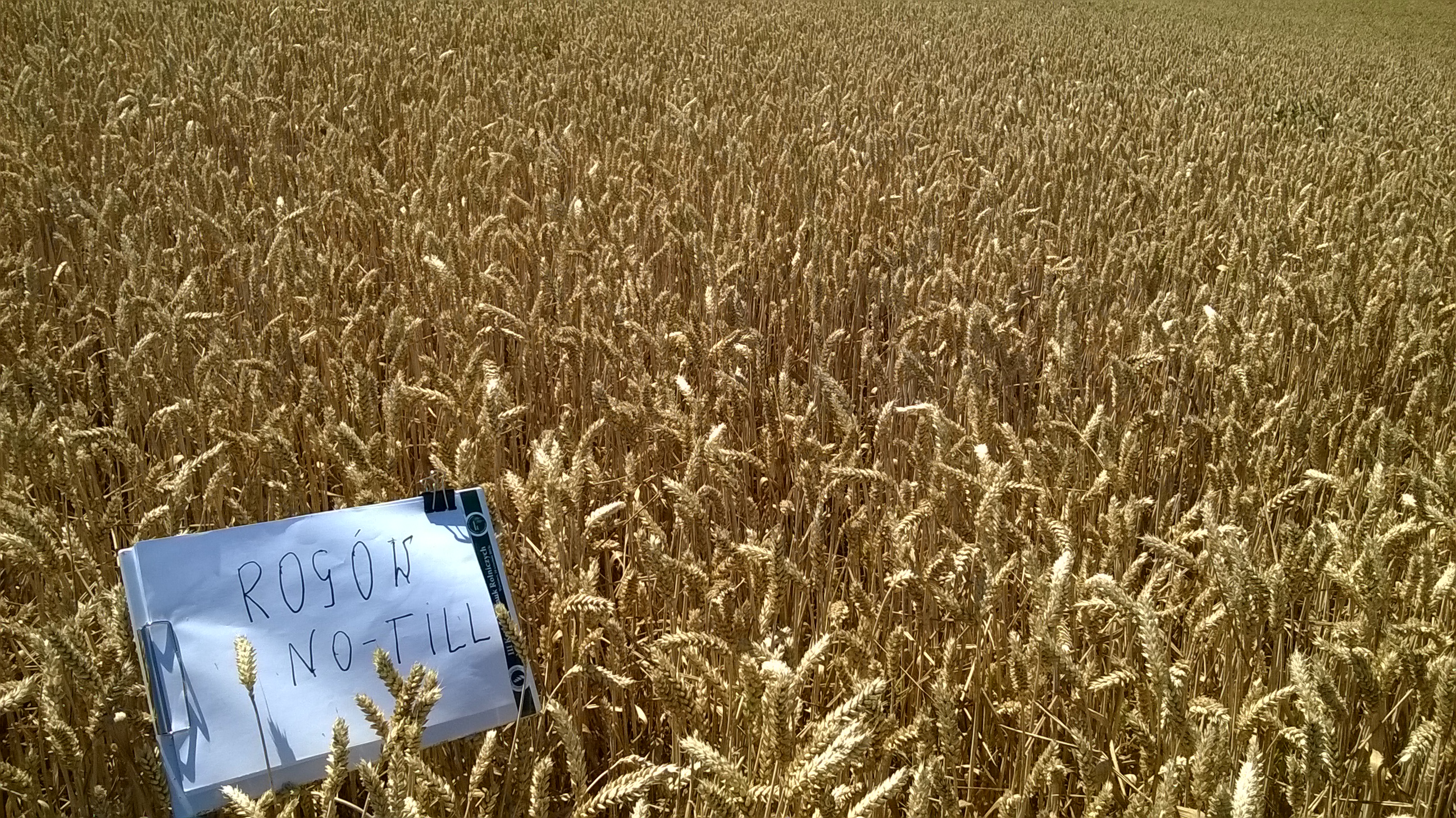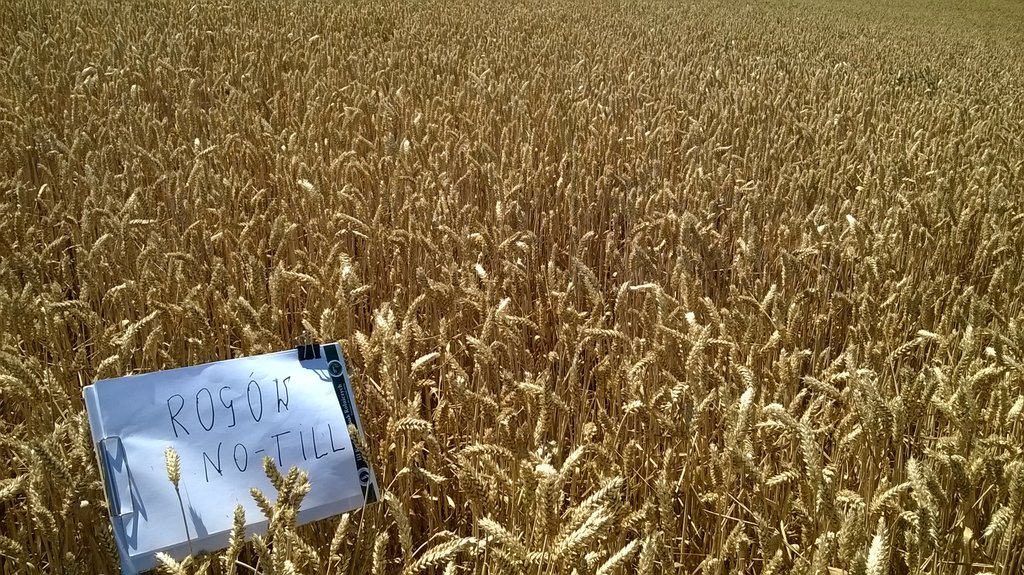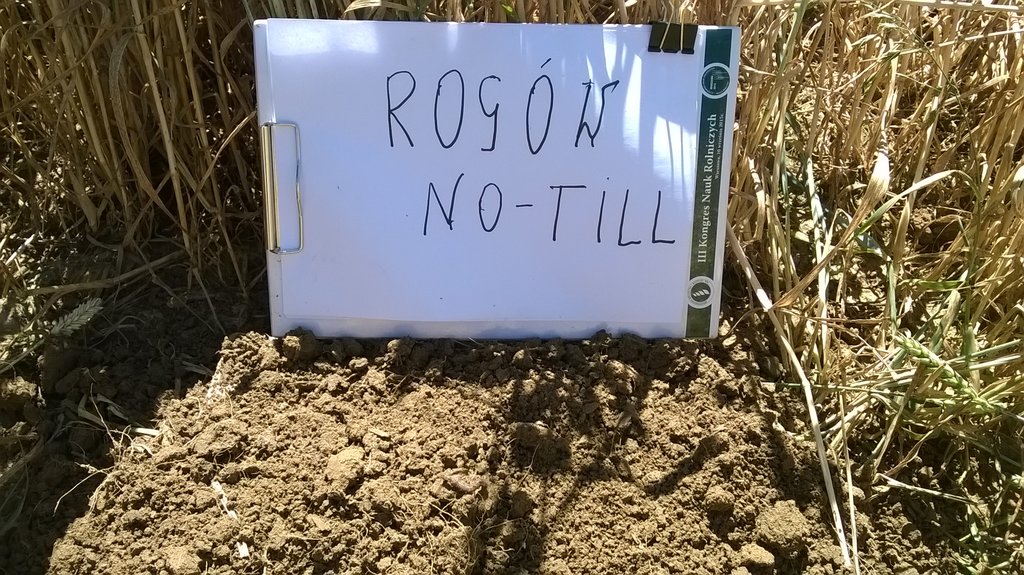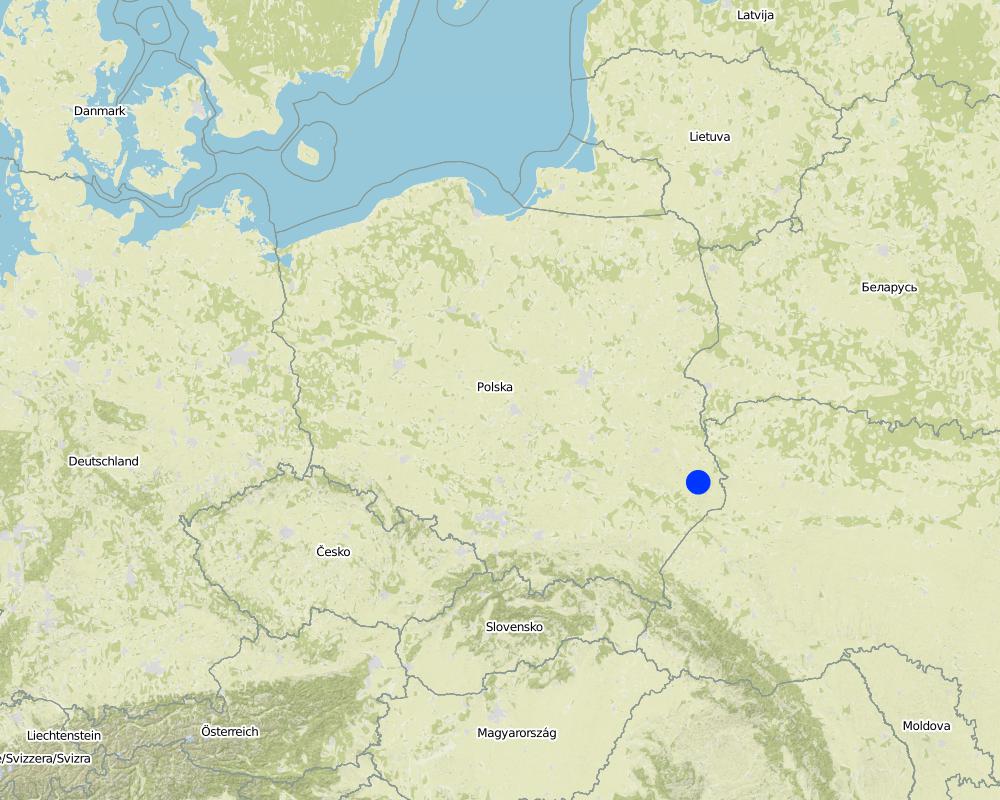No-till [Poland]
- Creation:
- Update:
- Compiler: Magdalena Frac
- Editor: –
- Reviewers: Ursula Gaemperli, Gudrun Schwilch, Alexandra Gavilano
No-till
technologies_2851 - Poland
View sections
Expand all Collapse all1. معلومات عامة
1.2 Contact details of resource persons and institutions involved in the assessment and documentation of the Technology
Lipiec Jerzy
Institute of Agrophysics, Polish Academy of Sciences
Poland
Usowicz Boguslaw
Institute of Agrophysics, Polish Academy of Sciences
Poland
Name of project which facilitated the documentation/ evaluation of the Technology (if relevant)
Interactive Soil Quality assessment in Europe and China for Agricultural productivity and Environmental Resilience (EU-iSQAPER)Name of the institution(s) which facilitated the documentation/ evaluation of the Technology (if relevant)
Institute of Agrophysics, Polish Academy of Sciences (IA PAS) - Poland1.3 Conditions regarding the use of data documented through WOCAT
The compiler and key resource person(s) accept the conditions regarding the use of data documented through WOCAT:
نعم
1.4 Declaration on sustainability of the described Technology
Is the Technology described here problematic with regard to land degradation, so that it cannot be declared a sustainable land management technology?
لا
2. Description of the SLM Technology
2.1 Short description of the Technology
Definition of the Technology:
No-till is a system where crops are planted into the soil without primary tillage.
2.2 Detailed description of the Technology
Description:
The technology is used in Rogów (N 50.80018 E 23.44883), in Zamosc Region in Poland under cereals or oil crops. The technology is used on about 700 ha area. The case study is embedded in a typical agricultural region on rather fertile soils formed from loess. The altitude at the study site is 238 m.a.s.l., average temperature 17.6°C and precipitation 563 mm. The farmer uses direct sowing technique and the following machines: stubble cultivator, seed drill with disc coulters and combine harvesters. The crop rotation includes the following crops: wheat/maize/wheat/rape. No-till, as well as minimum and reduced tillage, provides the opportunity to reduce energy requirements, increase soil organic matter content and protects the soil against erosion, runoff and compaction. No-till may often increase crop yields. The costs reduction for fuel making this technology more attractive commercially. No-till reduces CO2 emission from fuel during machinery usage. The presence of crop residues on the surface of soil layer can cause plant diseases. It is necessary to use some low amount of herbicides and fungicides in no-till.
2.3 Photos of the Technology
2.5 Country/ region/ locations where the Technology has been applied and which are covered by this assessment
بلد:
Poland
Further specification of location:
Rogów
Specify the spread of the Technology:
- evenly spread over an area
If precise area is not known, indicate approximate area covered:
- 0.1-1 km2
Comments:
Rogów, Poland, no-till, Coordinates: N 50.79988, E 23.4884
Map
×2.6 Date of implementation
If precise year is not known, indicate approximate date:
- 10-50 years ago
2.7 Introduction of the Technology
Specify how the Technology was introduced:
- during experiments/ research
Comments (type of project, etc.):
The farmer visited farms in the USA where the no-till technology is widely used. Then, he introduced the technology on his own farm in collaboration with local agricultural research units, including Institute of Soil Science and Plant Cultivation in Pulawy and Life Sciences University in Lublin.
3. Classification of the SLM Technology
3.1 Main purpose(s) of the Technology
- improve production
- reduce, prevent, restore land degradation
- conserve ecosystem
- preserve/ improve biodiversity
- reduce risk of disasters
- create beneficial economic impact
3.2 Current land use type(s) where the Technology is applied

الأراضي الزراعية
- Annual cropping
- wheat
Number of growing seasons per year:
- 1
3.4 Water supply
Water supply for the land on which the Technology is applied:
- rainfed
3.5 SLM group to which the Technology belongs
- minimal soil disturbance
3.6 SLM measures comprising the Technology

agronomic measures
- A1: Vegetation/ soil cover
- A3: Soil surface treatment
A3: Differentiate tillage systems:
A 3.1: No tillage
3.7 Main types of land degradation addressed by the Technology

soil erosion by water
- Wt: loss of topsoil/ surface erosion
3.8 Prevention, reduction, or restoration of land degradation
Specify the goal of the Technology with regard to land degradation:
- prevent land degradation
4. Technical specifications, implementation activities, inputs, and costs
4.1 Technical drawing of the Technology
Technical specifications (related to technical drawing):
Fig. 1. Crop residues on no-till field under rape
Fig. 2. Seed drill with disc coulters (seeds are introduced into the soil pneumatically)
Author:
Magdalena Frąc
Date:
21/07/2016
4.2 General information regarding the calculation of inputs and costs
Specify how costs and inputs were calculated:
- per Technology area
Indicate size and area unit:
1 ha
other/ national currency (specify):
PLN
If relevant, indicate exchange rate from USD to local currency (e.g. 1 USD = 79.9 Brazilian Real): 1 USD =:
0,28
Indicate average wage cost of hired labour per day:
50-100 PLN
4.5 Maintenance/ recurrent activities
| Activity | Timing/ frequency | |
|---|---|---|
| 1. | Rill opening of soil | Spring or autumn depending on the crop type |
| 2. | Direct sowing and fertilizing applied at once through direct sowing machine | Spring or autumn depending on the crop type |
4.6 Costs and inputs needed for maintenance/ recurrent activities (per year)
If you are unable to break down the costs in the table above, give an estimation of the total costs of maintaining the Technology:
360,0
Comments:
The costs refer to 1 hectare managed and include fertilizers, equipment and labour.
4.7 Most important factors affecting the costs
Describe the most determinate factors affecting the costs:
Cost of machinery appropriate to no-till and costs to meet bill of machinery contractor
5. Natural and human environment
5.1 Climate
Annual rainfall
- < 250 mm
- 251-500 mm
- 501-750 mm
- 751-1,000 mm
- 1,001-1,500 mm
- 1,501-2,000 mm
- 2,001-3,000 mm
- 3,001-4,000 mm
- > 4,000 mm
Agro-climatic zone
- sub-humid
5.2 Topography
Slopes on average:
- flat (0-2%)
- gentle (3-5%)
- moderate (6-10%)
- rolling (11-15%)
- hilly (16-30%)
- steep (31-60%)
- very steep (>60%)
Landforms:
- plateau/plains
- ridges
- mountain slopes
- hill slopes
- footslopes
- valley floors
Altitudinal zone:
- 0-100 m a.s.l.
- 101-500 m a.s.l.
- 501-1,000 m a.s.l.
- 1,001-1,500 m a.s.l.
- 1,501-2,000 m a.s.l.
- 2,001-2,500 m a.s.l.
- 2,501-3,000 m a.s.l.
- 3,001-4,000 m a.s.l.
- > 4,000 m a.s.l.
Indicate if the Technology is specifically applied in:
- not relevant
5.3 Soils
Soil depth on average:
- very shallow (0-20 cm)
- shallow (21-50 cm)
- moderately deep (51-80 cm)
- deep (81-120 cm)
- very deep (> 120 cm)
Soil texture (topsoil):
- medium (loamy, silty)
Soil texture (> 20 cm below surface):
- medium (loamy, silty)
Topsoil organic matter:
- medium (1-3%)
5.4 Water availability and quality
Ground water table:
5-50 m
Availability of surface water:
good
Water quality (untreated):
good drinking water
Is water salinity a problem?
لا
Is flooding of the area occurring?
لا
5.5 Biodiversity
Species diversity:
- high
Habitat diversity:
- medium
5.6 Characteristics of land users applying the Technology
Sedentary or nomadic:
- Sedentary
Market orientation of production system:
- commercial/ market
Off-farm income:
- less than 10% of all income
Relative level of wealth:
- average
Individuals or groups:
- individual/ household
Level of mechanization:
- mechanized/ motorized
Gender:
- men
Age of land users:
- middle-aged
5.7 Average area of land used by land users applying the Technology
- < 0.5 ha
- 0.5-1 ha
- 1-2 ha
- 2-5 ha
- 5-15 ha
- 15-50 ha
- 50-100 ha
- 100-500 ha
- 500-1,000 ha
- 1,000-10,000 ha
- > 10,000 ha
Is this considered small-, medium- or large-scale (referring to local context)?
- large-scale
5.8 Land ownership, land use rights, and water use rights
- family
Land use rights:
- individual
5.9 Access to services and infrastructure
health:
- poor
- moderate
- good
education:
- poor
- moderate
- good
technical assistance:
- poor
- moderate
- good
employment (e.g. off-farm):
- poor
- moderate
- good
markets:
- poor
- moderate
- good
energy:
- poor
- moderate
- good
roads and transport:
- poor
- moderate
- good
drinking water and sanitation:
- poor
- moderate
- good
financial services:
- poor
- moderate
- good
6. Impacts and concluding statements
6.1 On-site impacts the Technology has shown
Socio-economic impacts
Production
crop production
Comments/ specify:
The farmer observed increase of crop productivity in Mg per ha for the following plants: wheat, rape and maize. Grain yield of wheat under no-till vary from 8.8 to 11 t/ha. The yields are greater than those from average yield under conventional plough system.
crop quality
Comments/ specify:
The no-till technology increases crop quality by improving soil water retention.
risk of production failure
Comments/ specify:
The no-till technology decreases the risk of production failure due to greater yield stability.
land management
Comments/ specify:
The no-till technology simplified land management by less intense machinery traffic on the field.
Income and costs
expenses on agricultural inputs
Comments/ specify:
The expenses on agricultural inputs in no-till technology are reduced due to lower fuel costs.
workload
Comments/ specify:
The workload in no-till technology decreases by lower number of agricultural practices.
Socio-cultural impacts
food security/ self-sufficiency
Comments/ specify:
The no-till technology improves the food security by increased yield stability.
SLM/ land degradation knowledge
Comments/ specify:
Land degradation knowledge is improved by the promotion of the no-till technology.
Ecological impacts
Water cycle/ runoff
water quantity
Comments/ specify:
The water quantity increases in no-till technology due to less evaporation caused by crop residues on the surface of the soil.
water quality
Comments/ specify:
The water quality increases in no-till technology due to protection of soil against erosion and runoff.
harvesting/ collection of water
Comments/ specify:
The water collection in no-till technology is improved due to better infiltration of rainfall water through earthworms macropores open at the soil surface.
surface runoff
Comments/ specify:
The surface runoff in no-till technology decreased due to presence of crop residues on the field surface and open earthworms macropores increasing infiltration of rainfall water.
evaporation
Comments/ specify:
The no-till technology decreases evaporation due to crop residues on the soil surface.
Soil
soil moisture
Comments/ specify:
The no-till technology increases soil moisture by reduced evaporation due to crop residues on the soil surface and increasing soil organic matter content.
soil cover
Comments/ specify:
The no-till technology increases soil cover due to crop residues on the soil surface.
soil loss
Comments/ specify:
The no-till technology decreases soil loss due to reduced soil erosion and runoff.
soil accumulation
Comments/ specify:
The no-till technology increases soil accumulation due to increase of soil organic matter content.
soil crusting/ sealing
Comments/ specify:
The no-till technology reduces soil crusting and sealing by the presence of crop residuses and greater soil aggregates stability.
soil compaction
Comments/ specify:
The no-till technology reduces soil compaction due to greater bearing capacity of soil and due to less traffic on the soil.
nutrient cycling/ recharge
Comments/ specify:
The no-till technology increases nutrient cycling / recharge due to reduced surface runoff and associated nutrient losses and greated biodiversity.
soil organic matter/ below ground C
Comments/ specify:
The no-till technology increases soil soil organic matter content due to crop residues on the soil and less mineralization of organic matter.
acidity
Quantity before SLM:
5.8
Quantity after SLM:
6.9
Comments/ specify:
We observed increase of pH value (6.9) in no-till coil compared to conventionally tilled soil (5.8) that can be related with greater soil organic matter content in no-till soil.
Biodiversity: vegetation, animals
Vegetation cover
biomass/ above ground C
Comments/ specify:
The farmer observed increase of crop productivity.
beneficial species
Comments/ specify:
We observed greater quantity of earthworms under no-till compared to the conventional tilled soil.
pest/ disease control
Comments/ specify:
Pest/disease control increased in no-till technology due to proper application of pesticides.
Climate and disaster risk reduction
landslides/ debris flows
Comments/ specify:
The no-till technology decreases landslides/ debris flows by protection of soil against erosion and greater water storage. However, no landslides were not observed in the area.
emission of carbon and greenhouse gases
Comments/ specify:
The no-till technology desreases emission of carbon and greenhouse gases due to reduction of CO2 and other greenhouse gases realising by mechanical soil loosening.
6.4 Cost-benefit analysis
How do the benefits compare with the establishment costs (from land users’ perspective)?
Short-term returns:
slightly positive
Long-term returns:
positive
How do the benefits compare with the maintenance/ recurrent costs (from land users' perspective)?
Short-term returns:
slightly positive
Long-term returns:
positive
6.5 Adoption of the Technology
- 1-10%
If available, quantify (no. of households and/ or area covered):
The farmer covered about 700 ha by no-till technology.
Of all those who have adopted the Technology, how many did so spontaneously, i.e. without receiving any material incentives/ payments?
- 91-100%
Comments:
The farmer saw this technology in the USA and wanted to try it in Poland.
6.6 التكيف
Has the Technology been modified recently to adapt to changing conditions?
لا
6.7 Strengths/ advantages/ opportunities of the Technology
| Strengths/ advantages/ opportunities in the land user’s view |
|---|
| The increase of crop yield and production. |
| Prevention and reduction of erosion is widely observed under no-till. |
| Soil organic matter content increase is observed. |
| Strengths/ advantages/ opportunities in the compiler’s or other key resource person’s view |
|---|
| Soil structure improvement. |
| Decrease of environmental damage associated with soil inversion by ploughing. |
6.8 Weaknesses/ disadvantages/ risks of the Technology and ways of overcoming them
| Weaknesses/ disadvantages/ risks in the land user’s view | How can they be overcome? |
|---|---|
| Weed expansion | Herbicides application |
| Weaknesses/ disadvantages/ risks in the compiler’s or other key resource person’s view | How can they be overcome? |
|---|---|
| Plant diseases | Fungicides application |
7. References and links
7.1 Methods/ sources of information
- field visits, field surveys
4
- interviews with land users
1
- compilation from reports and other existing documentation
6
When were the data compiled (in the field)?
21/07/2016
Links and modules
Expand all Collapse allLinks
No links
Modules
No modules






